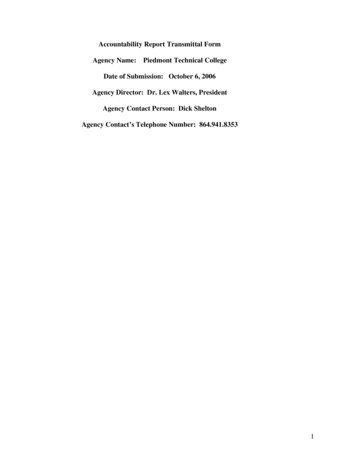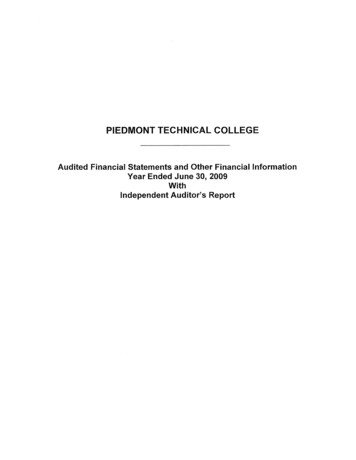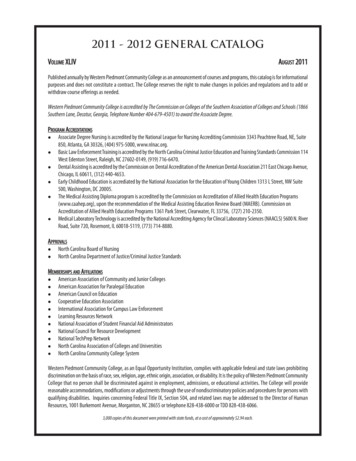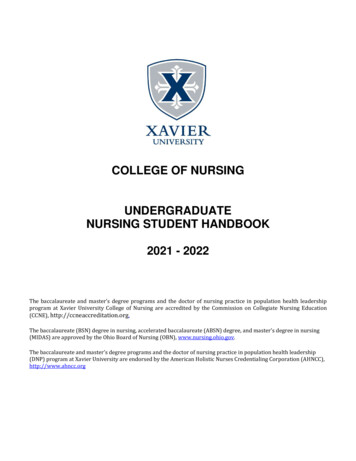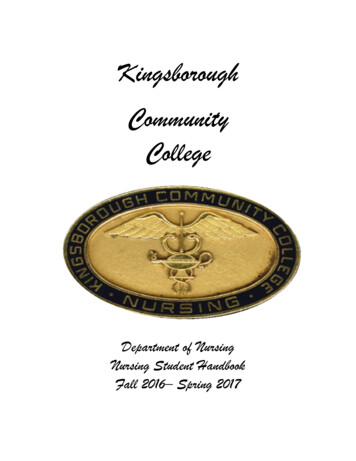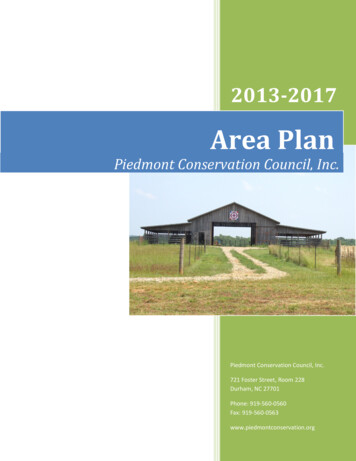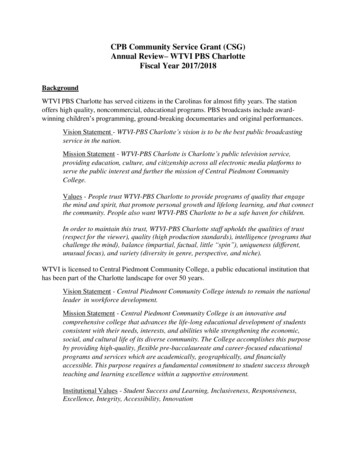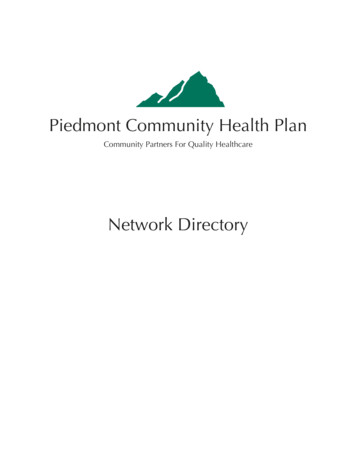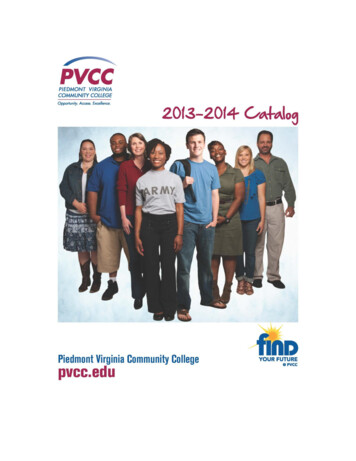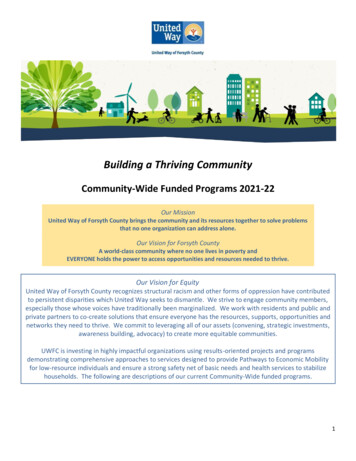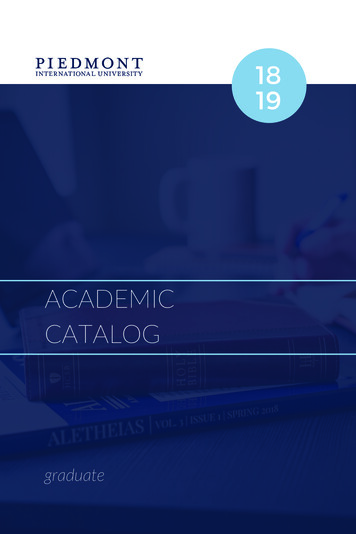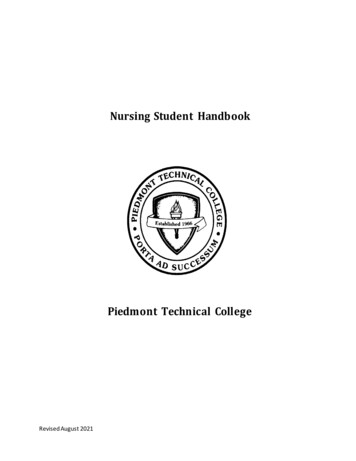
Transcription
Nursing Student HandbookPiedmont Technical CollegeRevised August 2021
Table of ContentsSection I: PhilosophyNursing Mission and GoalsThe PhilosophyOrganizing FrameworkConceptsPiedmont Technical College Institutional MissionPractical Nursing Program Student Learning OutcomesAssociate Degree Nursing Program Student Learning OutcomesNursing Program Outcome CriteriaAmerican Nurses’ Association Code of Ethics for NursesNational Student Nurses Association, Inc. Code of Professional ConductA Patient’s Bill of Rights44667779101112Section II: General Information for ADN and PN StudentsApproximate Cost of ADN ProgramApproximate Cost of PN ProgramAbsence Related to Student Nurses Association141516Section III: General Nursing Program InformationNursing OrganizationsDrug Calculation Test PolicySkills Checkoff PolicyTest/Exam PolicyPinning Uniform PolicyState Board ApplicationCOVID-19 PolicyATI Policy1819202125252627Section IV: Nursing Program Clinical PoliciesDress Code and Clinical Requirements40Student Signature Sheet42ii
SECTION I:Philosophy3
Nursing Mission Goals StatementThe purpose of the nursing division at Piedmont Technical College is to meet the uniquelearning needs of students by providing a quality education. This education preparesgraduate nurses to be caring, professional, and self‐motivated critical thinkers, who willprovide safe, quality care. Upon completion of the designated program, the student will beready to respond to the changing healthcare demands in a diverse society within therespective scopes of practice.The PhilosophyThe nursing division supports the mission, goals, and general competencies of PiedmontTechnical College. The faculty believes they have a responsibility to provide a nursingeducation that will prepare competent graduates who will provide safe, quality care by:Recognizing and meeting the unique learning needs of each student.Providing a safe and caring learning environment for students to acquire knowledgeand skills to care for all individuals and families across the lifespan.Building on a foundation of the sciences and humanities.Developing knowledge of the core concepts: patient centered care,teamwork/collaboration, evidenced based practice, quality improvement, safety,and informatics.Teaching and facilitating learning of knowledge and skills in caring, critical thinking,communication, cultural diversity, clinical decision‐making, professional behaviorsand teaching‐learning.Implementing a curriculum designed so that each level of practice builds onprevious knowledge to facilitate nursing education and career opportunities.The South Carolina Board of Nursing defines the practice of practical nursing as theperformance of health care acts that require knowledge, judgment, and skill and must beperformed under the supervision of the registered nurse or other health care practitionersauthorized by law to supervise licensed practical nurse (LPN) practice. The practice ofpractical nursing includes, but is not limited to:(a) Collecting health care data to assist in planning care of persons;(b) Administering and delivering medications and treatments as prescribed by anauthorized licensed provider;(c) Implementing nursing interventions and tasks;(d) Providing basic teaching for health promotion and maintenance;(e) Assisting in the evaluation of responses to interventions;4
(f) Providing for the maintenance of safe and effective nursing care rendered directly orindirectly;(g) Participating with other health care providers in the planning and delivering of healthcare;(h) Delegating nursing tasks to qualified others;(i) Performing additional acts that require special education and training and that areapproved by the board including, but not limited to, intravenous therapy and other specificnursing acts and functioning as a charge nurse.The associate degree registered nurse is prepared to provide nursing care within the scopeof practice defined by the South Carolina Board of Nursing. The role of the Associate DegreeRegistered Nurse (ADN) involves the health care acts in the nursing process includingassessment, analysis, intervention and evaluation. This practice requires specialized,independent judgment and skill and is based on knowledge and application of theprinciples of biophysical and social sciences. The practice of registered nursing includes,but is not limited to:(a) Assessing the health status of persons and groups;(b) Analyzing the health status of persons and groups;(c) Establishing outcomes to meet identified health care needs of persons and groups;(d) Prescribing nursing interventions to achieve outcomes;(e) Implementing nursing interventions to achieve outcomes;(f) Administering and delivering medications and treatments prescribed by an authorizedlicensed provider;(g) Delegating nursing interventions to qualified others;(h) Providing for the maintenance of safe and effective nursing care rendered directly orindirectly;(i) Providing counseling and teaching for the promotion and maintenance of health;(j) Evaluating and revising responses to interventions, as appropriate;(k) Teaching and evaluating the practice of nursing;(l) Managing and supervising the practice of nursing;(m) Collaborating with other health care professionals in the management of health care;(n) Participating in or conducting research, or both, to enhance the body of nursingknowledge;(o) Consulting to improve the practice of nursing; and(p) Performing additional acts that require special education and training and that areapproved by the board.5
Organizing FrameworkThe Piedmont Technical College Nursing Division’s organizing framework was developedfrom the college crest emphasizing the commitment and alignment with the college’seducational mission, goals, and general competencies. The organizing framework iscomposed of the six Quality and Safety Education for Nurses (QSEN) major concepts. Thecurricula reflect the relationship among and between these concepts.ConceptsNursing educators have always valued quality and safety yet changes in nursing practiceare requiring new approaches for preparing students to provide safe, quality care.Recognizing that the organizing framework is the foundation in which the curriculum isbuilt, the faculty developed the curriculum model based upon the six QSEN (Quality andSafety Education for Nurses, 2013) concepts which progress across the nursing curricula.Patient Centered Careo Recognize the patient or designee as the source of control and full partner inproviding compassionate and coordinated care based on respect for patient’spreferences, values, and needs.Teamwork/Collaborationo Function effectively within nursing and inter‐professional teams, fosteringopen communication, mutual respect, and shared decision‐making to achievequality patient care.Evidenced Based Practiceo Integrate best current evidence with clinical expertise and patient/familypreferences and values for delivery of optimal health care.Quality Improvemento Use data to monitor the outcomes of care processes and use improvementmethods to design and test/exam changes to continuously improve thequality andsafety of health care systems.Safetyo Minimizes risk of harm to patients and providers through both systemeffectiveness and individual performance.Informaticso Use information and technology to communicate, manage knowledge,mitigate error, and support decision making.6
Piedmont Technical College Institutional MissionPiedmont Technical College transforms lives and strengthens communities by providingopportunities for intellectual and economic growth.Practical Nursing Program Student Learning Outcomes:Patient centered careo Collaborate with others by incorporating sensitivity and respect indemonstrating concepts of patient centered care within culturally diversepopulations among individuals, families and communities. (Mission Goal 3)Teamwork and collaborationo Communicate professionally and function effectively under supervisionwithin nursing and other health care disciplines to achieve quality patientcare in response to the needs of individuals and families across the lifespanand the health illness continuum. (Mission Goal 2/5)Evidence based practiceo Provide interventions based on evidence-based practices to improve patientoutcomes across all healthcare populations. (Mission Goal 4)Quality improvemento Collect data and assist in implementing quality improvement measures withongoing evaluation to ensure patient safety across the healthcare continuum.(Mission Goal 2/6)Safetyo Assist in creating a safe environment that enhances quality of care forindividuals and families within culturally diverse populations.(Mission Goal 1)Informaticso Use basic technology skills for shared decision making and resolvingproblems in the delivery of care for individuals and families across thelifespan. (Mission Goal 4)Associate Degree Program Student Learning Outcomes:Patient centered careo Incorporate sensitivity and respect in demonstrating concepts of patientcentered care within culturally diverse populations among individuals,families and communities. (Mission Goal 3)Teamwork and collaborationo Communicate professionally and function effectively within nursing andother health care disciplines to achieve quality patient care in response to the7
needs of individuals and families across the lifespan and the health illnesscontinuum. (Mission Goal 2/5)Evidence based practiceo Integrate evidence-based practices to improve patient outcomes across allhealthcare populations. (Mission Goal 4)Quality improvemento Analyze data and implement quality improvement measures with ongoingevaluation to ensure patient safety across the healthcare continuum.(Mission Goal 2/6)Safetyo Create a safe environment that enhances quality of care for individuals andfamilies within culturally diverse populations. (Mission Goal 1)Informaticso Integrate appropriate technology for shared decision making and resolvingproblems in the delivery of care for individuals and families across thelifespan. (Mission Goal 4)8
Nursing Program Outcome CriteriaPiedmont Technical College Nursing programs use the following goals and outcomecriteria to measure the quality of its programs.1.Prepare students to be eligible to apply for the National Certification LicensureExamination.CRITERIA:70% of students will successfully complete each course to progressto subsequent courses.CRITERIA:85% of those students who successfully complete the program andmeet the requirements for writing the NCLEX will pass the exam onthe first attempt.2.Establish recommendations that will assist students in successfully completing theNursing Program.CRITERIA:3.Prepare students to work in acute/long term care facilities, clinics, physicianoffices and community-based facilities.CRITERIA:4.50% of the students will successfully complete the nursing programwithin 4 semesters from program entry for associate degree and 3semesters from program entry for practical nursing and LPN to ADNtransition programs.85% of the graduates who seek employment will be employedwithin six months to one year of graduation or actively pursuinghigher education courses.Meet students' expectations for the Associate Degree in Nursing or Practical NurseProgram.CRITERIA:85% of graduates responding to the faculty course evaluation formwill rate the course met their expectations.9
Nursing students at Piedmont Technical College will abide and follow the American Nurses’Association code of Ethics for Nurses, the National Student Nurses Association Code ofProfessional Conduct, and The Patient’s Bill of Rights.American Nurses' Association Code of Ethics for NursesProvision 1: The nurse practices with compassion and respect for the inherent dignity,worth, and unique attributes of every personProvision 2: The nurse’s primary commitment is to the patient, whether an individual,family, group, community, or population.Provision 3: The nurse promotes, advocates for, and protects the rights, health, and safety ofthe patient.Provision 4: The nurse has the authority, accountability, and responsibility for nursingpractice; makes decisions; acts consistent with the obligation to promote health and toprovide optimal care.Provision 5: The nurse owes the same duties to self as others, including the responsibility topromote health and safety, preserve wholeness of character and integrity, maintaincompetence, and continue professional growth.Provision 6: the nurse, through individual and collective effort, establishes, maintains, andimproves ethical environment of work settings and conditions of employment that areconducive to safe, quality healthcare.Provision 7: The nurse in all roles and settings, advances the profession through researchand scholarly inquiry, professional standards development, and the generation of bothnursing and health policy.Provision 8: The nurse collaborates with other health professionals and the public to protecthuman rights, promote health diplomacy, and reduce health disparities.Provision 9: the profession of nursing, collectively through its professional organizations,must articulate nursing values, maintain the integrity of the profession, and integrateprinciples of social justice into nursing and health policy.Revised ANA, 201510
National Student Nurses Association, Inc. Code of Professional ConductAs a member of the National Student Nurses’ Association, I pledge myself to:1. Maintain the highest standard of personal and professional conduct.2. Actively promote and encourage the highest level of ethics within nursingeducation, the profession of nursing, and the student nurses’ association.3. Uphold all Bylaws and regulations relating to the student nurses’ association atthe chapter, state and national levels, reserving the right to criticize rules andlaws constructively, but respecting the rules and laws if they prevail.4. Strive for excellence in all aspects of decision‐making and management at alllevels of the student nurses’ association.5. Use only legal and ethical principles in all association decisions and activities.6. Ensure the proper use of all association funds.7. Serve all members of the student nurses’ association impartially, provide nospecial privilege to any individual member, and accept no personal compensationfrom another member or non‐member.8. Maintain the confidentiality of privileged information entrusted or known to meby virtue of an elected or appointed position in the association.9. Refuse to engage in, or condone, discrimination on the basis of race, gender, age,citizenship, religion, national origin, sexual orientation, or disability.10. Refrain from any form of cheating or dishonesty and take action to reportdishonorable practices to proper authorities using established channels.11. Always communicate internal and external association statements in a truthfuland accurate manner by ensuring that there is integrity in the data andinformation used by the student nurses’ association.12. Cooperate in every reasonable and proper way with association volunteers andstaff, and work with them in the advocacy of student rights and responsibilitiesand the advancement of the profession of nursing.13. Use every opportunity to improve faculty understanding of the role of the studentnurse’s association.14. Use every opportunity to raise awareness of the student nurses’ association’smission, purpose, and goals at the school chapter level.15. Promote and encourage entering nursing students to join and become active inNSNA16. Promote and encourage graduating seniors to continue their involvement byjoining professional nurses’ association upon licensure as registered nurses.Adopted by the 1999 House of Delegates, Pittsburgh, PA at the 47th Annual NSNAConvention.Reference: American Society of Association Executives and the National Society forFundraising Executives.11
A Patient’s Bill of Rights1.2.3.4.5.6.7.8.9.10.11.12.The patient has the right to considerate and respectful care.The patient has the right to and is encouraged to obtain from physicians andother direct caregivers relevant, current, and understandable informationconcerning diagnosis, treatment, and prognosis.The patient has the right to make decisions about the plan of care prior to andduring the course of treatment and to refuse a recommended treatment or planof care to the extent permitted by law and hospital policy and to be informed ofthe medical consequences of this action.The patient has the right to have an advance directive (such as living will, healthcare proxy, or durable power of attorney for health care) concerning treatment ordesignating a surrogate decision maker with the expectation that the hospital willhonor the intent of that directive to the extent permitted by law and hospitalpolicy.The patient has the right to every consideration of privacy.The patient has the right to expect that all communications and recordspertaining to his/her care will be treated as confidential by the hospital, exceptin cases which as suspected abuse and public health hazards when reporting ispermitted or required by law.The patient has the right to review the records pertaining to his/her medicalcare and to have the information explained or interpreted as necessary, exceptwhen restricted by law.The patient has the right to expect that, within its capacity, and policies, ahospital will make reasonable response to the request of a patient forappropriate and medically indicated care and services.The patient has the right to ask and be informed to the existence of businessrelationships among the hospital, educational institutions, other health careproviders, or payers that may influence the patient’s treatment and care.The patient has the right to consent to or decline to participate in proposedresearch studies or human experimentation affecting care and treatment orrequiring direct patient involvement, and to have those studies fully explainedprior to consent.The patient has the right to expect reasonable continuity of care whenappropriate and to be informed by physicians and other caregivers of availableand realistic patient care options when hospital care is no longer appropriate.The patient has the right to be informed of hospital policies and practices thatrelate to patient care, treatment, and responsibilities.American Hospital Association. (1992). A patient’s bill of rights.12
SECTION II:GENERALINFORMATION FORADN AND PN STUDENTS13
Approximate Cost of ADN ProgramPlease note these are approximate costs. Please plan your finances accordingly.Tuition – Cost is according to county of residence for 4 semesters.1. Books and supplies ‐ 3500.00.2. Clinical Fee ‐ 25‐50 per each semester3. Malpractice insurance ‐ 10/per semester4. Uniforms ‐ 300.005. ATI ‐ 2000.006. Graduation Uniform ‐ 607. State Board and Pearson Vue ‐ 297.008. Nursing Pin ‐ 10.009. Student Nurse Association 50.00/year x 210. Castlebranch Document Manager, Drug Test/exam, and Background Record CheckSystem ‐ 12011. Physical examination and immunizations ‐ approximately 400.00 but will varydepending on immunizations needed.12. Workshops ‐ 100.0013. CPR ‐ 100.00In addition to fees above, you are responsible for having:A watch capable of reading seconds, stethoscope, pen light, blood pressure cuff, current CPR,reliable transportation and travel expenses (including meals) to each clinical site.14
Approximate Cost of PN ProgramPlease note these are the appropriate costs. Please plan your finances accordingly.Tuition – Cost is according to county of residence for 3 semesters.1. Books and supplies ‐ 3400.00.2. Clinical Fee ‐ 25‐ 50 per semester3. Malpractice insurance ‐ 10/per semester4. Uniforms ‐ 300.005. ATI ‐ 1900.006. Graduation Uniform ‐ 607. State Board and Pearson Vue ‐ 297.008. Nursing Pin ‐ 10.009. Castlebranch Document Manager, Drug Test/exam, and Background Record CheckSystem ‐ 12010. Physical examination and immunizations ‐ approximately 400.00 but will varydepending on immunizations needed.11. Workshops ‐ 100.0012. CPR ‐ 100.00In addition to fees above, you are responsible for having:A watch capable of reading seconds, stethoscope, blood pressure cuff, pen light, current CPR,reliable transportation and travel expenses (including meals) to each clinical site.15
General InformationAbsences Related to Student Nursing AssociationStudents may attend local, state, or national Student Nurses Association activities or otherprofessional activities approved by faculty in lieu of lecture and/or clinical in nursingclasses. Students must:1.2.Notify course and clinical instructors in writing (or by e‐mail) at leastthree weeks prior to the activity.Attend the entire activity in order to receive credit for lecture and/or clinical.Verification of attendance of the entire activity will be required. For example,the SNA‐SC convention, a very popular student activity, begins on Thursdayafternoon with the keynote address and ends Saturday night following thebanquet. Students opting to receive lecture and/or clinical credit for attendingthe convention must be present from Thursday afternoon through Saturdaynight. Activities that require attendance include the keynote address, breakoutsessions, House of Delegates meetings, PTC’s caucus, Jeopardy, the Spiritluncheon (Friday) and the banquet (Saturday night). Students not attendingconvention for lecture and/or clinical credit are encouraged to attend anyportion of the convention. For example, vendors are generally available onSaturday. This is an excellent opportunity for students to explore careeropportunities.NOTE: This policy only applies to nursing courses. Attendance and course absencesin other general education courses will need to be approved by that individualinstructor.Students who become sick or injured must notify the PTC faculty representative present atthe activity. Students not attending activities to receive credit for lecture and/or clinical arenot required to attend the entire activity or present verification of attendance.16
SECTION III:GENERAL NURSING PROGRAM INFORMATION17
Nursing OrganizationsAll nursing students are encouraged to participate in their respective studentassociations. Students may also be elected or appointed to nursing, college‐wide, or statecommittees. Students so designated are encouraged to accept and fulfill theresponsibilities of committee participation.Student Nurses’ AssociationPurpose:A.B.C.To assume responsibility for contributing to the nursing profession inorder to provide for the highest quality health care;To provide programs representative of fundamental and current professionalinterest and concerns;To aid in the development of the whole person, his/her professional role,and his/her responsibility for the health care of people in all walks of life.Dues: 50.00 per yearNursing Honor Society ‐ Lambda Chi Nu ‐ Beta ChapterPurpose:1.2.3.Recognize superior academic accomplishments within the Associate DegreeNursing (ADN).Recognize the development of superior clinical nursing qualities.Strengthen commitment to the ideals and purposes of the nursingprofession.Membership:A member is defined as a student entering the second semester of ADN nursingcourses. Prospective members shall have a grade average of greater than or equal to2.5 on a four‐ point scale in the Associate Degree Nursing Core Curricula. Membersmust also demonstrate and maintain outstanding academic achievement,professionalism, and clinical nursing excellence.Induction and lifetime member dues: 55.00PN Care ClubThe PN Care Club is open to all students enrolled in the practical nursing program. Theclub unites students to support and promote the profession, encourages communityservice involvement, and provides networking opportunities among state and nationalorganizations.The PN Care Club has also collaborated with the National Association of Licensed PracticalNurses, Inc. (NALPN) to recognize nursing students who have demonstrated exemplary18
academic achievement in the practical nursing program. Students who achieve a GPA of 3.0or higher in their practical nursing coursework will be eligible to receive the NALPNStudent Honor Society Achievement Award.Dues: 25.00 per yearDrug Calculation Test PolicyThe nursing faculty at Piedmont Technical College recognizes that medicationadministration is an integral part of the professional duties of a nurse.Basic dosage calculations will be taught in NUR 139 and PNR 122 and will include solid andliquid oral dosages, injectable medications, and reconstitution of powders and liquids. Ineach course, a Drug Calculation Competency test consisting of 20 questions will be given. Aminimum score of 95% must be achieved on this test within 3 attempts. If unsuccessful, thestudent may withdraw from the course (if prior to the withdrawal period) or choose toremain in the course and receive an “F” for the course which will both count as an attemptin the nursing program.For the ADN students, more advanced concepts including all intravenous medicationcalculations, titrations, blood administration, and parenteral nutrition will be taught in NUR203. In these courses, a Drug Calculation Competency test consisting of 20 questions willbe given. A minimum score of 95% must be achieved on this test within three attempts. Ifunsuccessful, the student may withdraw from the course (if prior to the withdrawalperiod) or choose to remain in the course and receive an “F” for the course which will bothcount as an attempt in the nursing program.Pediatric safe dosages and other course specific drug calculations will be taught and testedon in the specialty courses throughout the nursing programs.In order to maintain the safety and integrity of our clients, dosage calculation concepts willbe integrated into all course and clinical instruction to allow faculty to reinforce conceptsand monitor students’ progress and retention of information.19
Skills Checkoff PolicySkills are verified through timed skills checkoffs in NUR 101, NUR 139, NUR 157, NUR 203,PNR 110, and PNR 122, PNR 128. Skill checkoff sheets will be used to grade student’sperformance on various skills necessary to provide safe patient care.Policy Regarding Lab Skills CheckoffsIn each course in which skills are verified through timed skills checkoffs (NUR 101, NUR139, NUR 157, NUR 203, PNR 110, PNR 122, PNR 128) the student can only score less than75% on one (1) of the checkoffs on the first attempt and must then successfully pass (with a75% or greater) on any repeated checkoff within 1 additional attempt. In the event thestudent is unable to successfully complete either of these requirements, the student maywithdraw from the course (if prior to the withdrawal period) or choose to remain in thecourse and receive an “F” for the course which will both count as an attempt in the nursingprogram.Any missed checkoffs (due to a tardy or absence or late video submissions) on theoriginally scheduled date will result in a 0 for that skill. There will be no make-ups for thatskill.Skills check off sheets are used as a study tool for students as they practice however, todemonstrate competency during the graded check off skills these sheets should not beused by the student. During the skills check off the student should not have the skills checkoff sheet in view and should only have approved/needed supplies for skill. If a skillscheckoff sheet is visible during a graded checkoff an unsuccessful will be recorded and thiswill result in a 0 for that skills. There will be no make-ups for that skill.*See individual course information sheet and clinical handbook for specific skills checkoff, and clinical requirements.Test/Exam Policy20
It is strongly recommended that all personal items be left in the student’s personalvehicle. PTC is not liable for any items left outside of the classroom. Violation of thesepolicies may result in adhering to the Student Code of for the South Carolina TechnicalCollege System.While taking all tests/exams students MUST: Only bring the following items for tests/exams: pencil (if applicable), earplugs (ifdesired) and car keys. At the time a student is found with any other items not allowedduring tests/exams, the student will be required to immediately submit theirtest/exam. Only the completed questions when submitted will be graded and anyunanswered questions will be counted as incorrect. During virtual testing studentshould only have pencil (if applicable), blank sheet of paper (if applicable), andearplugs (if desired) in the testing area. Cell phones/electronic devices are not allowed in the classroom when studentsare taking tests/exams. At the time a student is found with a cellphone/electronic device during tests/exams, the student will be required toimmediately submit their test/exam. Only the completed questions whensubmitted will be graded and any unanswered questions will be counted asincorrect. During virtual testing student should not have any cellphones/electronic devices in or around their testing area. Electronicdevices should be outside of the room when testing. Only those students who are in their seats (and logged into D2L if applicable) atthe scheduled test/exam time will be allowed to take the test/exam that day.Any students arriving late will be required to make up the test/exam at the endof the semester or at the instructor’s discretion. Students should be logged inat the assigned testing time (during assigned class time) and should startpromptly at scheduled start time. (In the event of technology issues, thestudent should immediately email the instructor via D2L or as advised byyour instructor) Students will NOT be permitted to test if not logged in atthe assigned testing time. Ex: if your class is Tuesday at 0830 your testwill be assigned Tuesday at 0830 and student should be logged in andready to test. Once the test/exam has been started, students will not be allow
The purpose of the nursing division at Piedmont Technical College is to meet the unique learning needs of students by providing a quality education. This education prepares graduate nurses to be caring, professional, and self‐motivated critical thinkers, who will provide safe, quality care.
